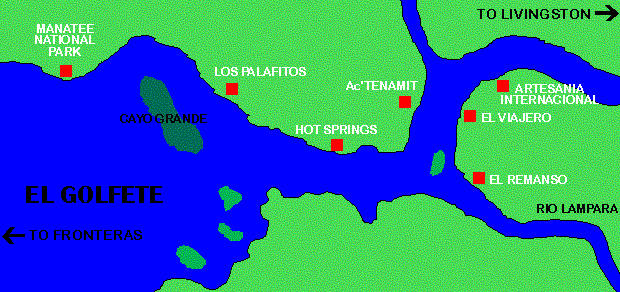
Klik -
her eller under billedet for at komme videre!
Naturen omkring Rio Dulce. Læs om stedets
klima her.
Med kano eller en anden lille båd
kan man studere tropisk plante- og dyreliv på allernærmeste hold
| Fugle | Pattedyr | Fisk |
| Krybdyr og padder | Insekter | Planter |
Terrain
There is not much change in elevation along the Rio Dulce. From the westernmost end of Lake Izabal to the Bahia de Amatique, there is only about a 1 meter drop.
Even so, the current in the river is strong in places. At one point in the limestone canyon not far from Livingston, the river narrows, deepens to more than 70 feet and makes a sharp turn. Here it becomes obvious that there's a lot of water flowing down the Rio Dulce.
The bedrock in the Rio Dulce area is limestone which is exposed in some places such as along the canyon mentioned above. Apart from the limestone canyon section of the Rio Dulce, the river flows through a level valley several miles wide between two sets of low rolling hills. Some of the hills rise to 600 meters (1800 feet).
Dense vegetation occurs along the shores of the river, El Golfete and Lake Izabal, but some of the land between the river and the hills has been clearcut and is now pastureland with great expanses of tall grasses and occasional cornfields.
Tropical Forests
Much of the area surrounding the Rio Dulce is dense tropical rain forest with its numerous sub-habitats and profusion of life forms. It is easy to visit primary rain forest containing mature hardwood trees including teak and mahogany along with many other species. Bromeliads, epiphytes, and vines exist in profusion in the rain forest.
Mangroves & Wetlands
Mangrove forests are found along the shores of the Rio Dulce and especially around El Golfete. During the dry season, the river level drops more than a meter and the tangle of mangrove roots is well exposed. The first ten meters in front of the mangroves is often densely filled with tall reeds (siv). The tangle of mangrove roots and reeds provide an ideal habitat for many species of fish and amphibians and even manatees, especially in MANATEE NATIONAL PARK.

Rivers
Dozens of rivers and countless small streams feed the Rio Dulce. Tributaries are to be found at frequent intervals all along the shores of Lago Izabal, El Golfete and the Rio Dulce. Many of these rivers are deep and relatively clear of obstructions and easily navigable. In a small skiff or cayuco it is often possible to travel several miles up these tributaries.
As you travel up some of the tributary rivers, you will first pass through dense tropical jungle, then the scenery opens up and you find yourself passing through pastures where there are occasional herds of cattle and horses. Further along, the scenery reverts to dense forest. Along the way you might encounter monkeys or parrots in the trees, tarpon and snook in the often crystal clear water. You might even spot a caiman (alligator). These areas are teeming with life and as you pass from one spot to another it is fascinating to observe the micro-ecologies in each.
Marine
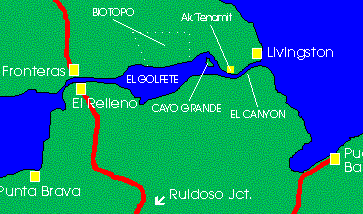
At the mouth of the river is the town of Livingston. Here, the fresh water of the Rio Dulce rolls into the saltwater of the Bahia de Amatique and in this transition zone you will find additional life forms thriving in abundance. Here, the marine life supports an amazing concentration of birds. At times there are hundreds in the air at once including pelicans and magnificent frigatebirds. This area supports a large fishing industry. The shrimp boats are out dragging their nets almost every night. But there are fears it is being over-harvested. The fisherman complain that their catch is far smaller than in the past.
The Rio Dulce and surrounding area is a bird watcher's paradise. All of Guatemala offers great bird watching but around the Rio Dulce you can see an exceptionally large number of species because the jungle is adjacent to fresh water, wetlands and the sea so can see all these types of birds together.
Common sights are various herons including the 40 inch tall Great White Heron, Egrets (hejrer), Hummingbirds (kolibrier), Kingfishers (isfugle), Great Kiskadee, various Orioles, Parrots and Hawks along with many small birds that live and nest low in the trees and bushes.
The tapir is a nocturnal, herbivorous mammal of the genus Tapirus that is found in the jungles of Central America and other parts of the world. The tapir is harmless and very shy. If you should be lucky enough to see one, you will notice it is a very odd looking animal, being related to the horse and to the rhinoceros. It is about the size of a donkey and somewhat piglike in appearance with a long flexible snout and short legs. Tapirs grow up to as much as 600 pounds. The skin is gray like an elephant and their snout is very agile. At the very beginning of the movie "2001: A Space Odyssey", the animals depicted as being hunted by the "apes" are tapirs. Tapirs live in forests, browsing on twigs. They swim well and can run fast when in danger. The species found in Guatemala, Baird's tapir (Tapirus bairdi), has been hunted for its meat for thousands of years and does not appear to be endangered but it is threatened by the destruction of its rain-forest habitat.
The jaguar is the most sacred animal to the Mayas and the Aztecs. Long ago it was common from southern Mexico through northern Argentina. Today the jaguar is endangered because of reduced habitat and hunting. The jaguar was hunted for its pelt and by farmers because it preys on calves and pigs. The coloring of a jaguar is usually golden yellow with black spots. Rarely a jaguar will be entirely jet black. The jaguar is rare and you are unlikely to see one. Jaguars are not known to attack man but if you do see one it would be wise to give it a wide berth.
The ocelot is a beautiful animal the size of an overgrown housecat and colored with black stripes and spots and tan spots on a gray background. The ocelot has the large eyes of a nocturnal hunter. They are hard to find but occasionally an ocelot cub will be captured up in the hills around the Rio Dulce and taken in as a house pet.
The howler monkey should have been called the "roaring monkey". The howler monkey is equipped with a unique throat apparatus that enables it to make a loud roar like a gorilla. At numerous points around the Rio Dulce the jungle erupts with their roars at sunrise and sunset. If you venture into an area containing howlers up in the trees be advised that the monkeys will harass you by throwing anything they can get their hands on. It's very amusing.
The spider monkey found in the Rio Dulce area is one of several American species of small monkey of the family Cebidae and genus Ateles. The spider monkey has no thumb, long slender limbs and great agility. It has a long prehensile tail which it uses very effectively to hold onto branches. They travel through the trees in small bands, moving swiftly by making tremendous leaps, sprawling out like spiders, and grasping tree limbs with their prehensile tails. The fur is yellowish-gray to brown, with lighter undersides; the face has white eye rings and is shaded by projecting hair that is either light or dark in color. The animals mainly eat fruits supplemented with nuts, seeds, leaves, insects, and eggs. Locally, the spider monkey is known as the "Capuchino" because it face and facial coloring have a somewhat "religious" look.
The manatee or sea-cow is an endangered species that inhabits parts of the Rio Dulce. On the north shore of El Golfete is the Biotopo de Chocon Machacas which is a nature preserve designed to protect the habitat of the manatee. The manatee is large, weighing up to 2,000 pounds but is harmless and extremely shy. Because of their shyness the odds of seeing one are very small. If you are to have any chance at all, you must explore the Biotopo with a canoe or other unpowered boat.
The manatee is presumed to be the basis of the mermaid myth. The manatee cradles its young in its flippers when it breast-feeds them. When it breaks the surface to breathe you might mistake it for a much smaller fish but its overlapping snout and whiskers are distinctive.
Numerous species of bat can be found around the Rio Dulce but one that you will surely see after dark is the fishing bat. After dark, the very large fishing bat can be seen swooping low and fast, skimming the water and locating its targets by sonar.
Fishermen will certainly not be disappointed as the Rio Dulce is abundantly filled with fish of many types. Everywhere along the river it is possible to look into the water and see fish of all sizes swimming. The Indians fish the river with hand thrown nets from morning until night. Other Indians place crab traps on the bottom.
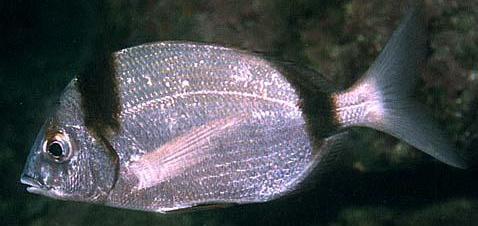
mojarra
The most common food fish taken from the Rio Dulce is the "mojarra", a delicious fish related to the sunfish or perch. The most sought after fish is the "robalo" (snook) which produces beautiful boneless filets. The robalo is often a large fish and is a great fighter. During the dry season when the river's current comes almost to a halt, various fish from the sea some up the Rio Dulce including the prized sportfish, the tarpon (Megalops atlanticus). Even dolphins venture up the Rio Dulce into El Golfete.
Krybdyr og padder Tilbage til oversigt
Frogs and toads are abundant along the Rio Dulce. While they seem small, soft and vulnerable, many defend themselves by secreting poison through their skin. Some tropical frogs secrete some of the most powerful toxins known which can cause instant paralysis of the heart muscle and immediate death. Fortunately, most of these poison frogs are found farther south in Costa Rica, Panama and South America. Nevertheless, these toxins are transmitted by skin contact so you should avoid touching toads and frogs.
Visitors should take care when letting pet dogs run loose, especially near bodies of water. Dogs can die from eating certain frogs and toads. Dogs that grow up in the this area learn to leave these amphibians alone.
Caimans can be found in certain parts along the Rio Dulce. They are often submerged with just the nostrils and eyes above the water and are indistinguishable from a submerged log -- although they can sometimes be seen sunning themselves on muddy riverbanks. For a closeup view of these creatures, the town of El Estor maintains a fenced pool in the city park containing three or four healthy caimans. Crocodiles up to 17 feet in length have also been reported. Such monster crocodiles are reputed to attack and kill horses but the veracity of these reports is questionable.
Dragon-like iguana lizards can be found around the Rio Dulce and are known for their impressive courting and defensive displays, such as raising their bodies and bobbing their heads vigorously. Lizards of the iguana family are similar to the agamine lizards of Eurasia, except that their teeth are solidly joined to the inner edge of the jaw instead of to the margin of the jawbone. Iguanas have distinct eyelids, large external eardrums, and often conspicuous throat pouches, or dewlaps. Each limb has five free toes ending in sharp claws. Unlike most other lizards, iguanas are vegetarians.
The green iguana (Iguana iguana of the family Iguanidae) can grow up to 1.8 meters (6 feet) in length and its flesh and eggs are valued as food.

Grøn leguan
Look carefully for them resting on the branches of trees overhanging the water. They are very shy and will scurry away if you try to approach them.
At all points along the Rio Dulce, be on the lookout for the "Jesus Christ Lizard" which can often be seen running upright on its hind legs across the surface of the water. Basilisk lizards are members of the iguana family. They are fierce looking creatures that grow up to 70 cm (28 inches) long but are shy and harmless. They eat mostly insects. Basilisks can move with lightning speed on their powerful hind legs and can scale a tree in the wink of an eye. Their hind legs are so fast and powerful that they can run across the surface of the water. This ability has earned them the name of "Jesus Christ Lizard".
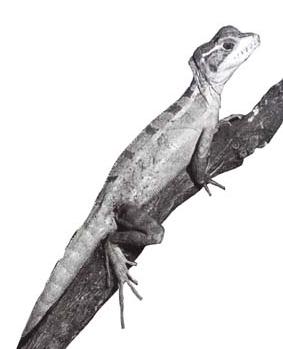
Basiliscus vittatus
The variety commonly found around the shores of the Rio Dulce is the banded basilisk, Basiliscus vittatus of the family Corytophanidae, which has a yellow stripe along each side of its brownish-black body.
Along the Rio Dulce you may occasionally encounter snakes. The vast majority are not venomous. Most snakes are nocturnal and well camouflaged during the day and the odds of running into any snake, let alone a venomous snake and getting bitten by one is extremely small. Most snakes are afraid of you and will quietly move away when they feel the vibration of your footsteps.
Most snakes make use of camouflage but the venomous coral snake is brightly colored with rings of red, yellow and black. It is easily spotted and avoided. The false coral snake is not venomous but imitates closely the coral snake's colorations to frighten off predators.
Easily the most dangerous and most aggressive snake is the bushmaster which can grow to 6 feet in length. It is the largest venomous snake in all the Americas. The bushmaster is not afraid of people and will sometimes give chase. Fortunately, the bushmaster is extremely rare around the Rio Dulce as it prefers mountainous country.
The most common poisonous snake is the fer-de-lance, also called the yellow-jawed tommygoff or terciopelo. Locally, the fer-de-lance is known as the barba amarilla (yellow beard). The fer-de-lance can sometimes be found along the river at night. They can also be found in the grassy plains in the Rio Dulce valley. In the daytime they are well camouflaged, blending in with a tree branch or resembling a big pile of leaves on the ground and are very difficult to spot. The fer-de-lance is one of the few snakes that will attack without provocation and aggressively pursue its target. It is quite dangerous. They are usually killed when encountered.
The most obvious and flamboyant insects along the Rio Dulce are, without question, the butterflies. They can be seen all day long flashing colorfully by. The most striking of these is easily the blue morpho which grows to 5 inches across and is colored a bright electric blue.
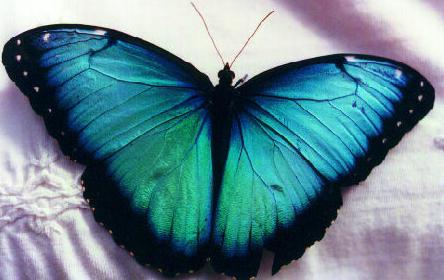
Blue morpho
Other butterflies are colored yellow and green, orange and black and many other variations. Another striking butterfly has red and silver wings. The idea behind the bright colors is to frighten or startle predators. The underside of the butterfly's wings are usually a drab color so when they come to rest and lock their wings upright, they blend in and are well camouflaged. Butterflies are best seen in the morning hours from 8 AM until noon.
Along with the colorful butterflies during the daytime come a spectacular array of moths at night. There are so many different kinds of moths, it seems that you never see the same type twice. Some of the moths grow to enormous size as well and 4 to 6 inch specimens are not uncommon.
There are many kinds of ants in the Rio Dulce area ranging from microscopically small household ants to large leaf-cutter ants and huge "bullet ants" that look like two blackberries walking one after the other. Some ants will bite and leave a fiery and very itchy welt so watch where you stand, especially if you are going bareoot or wearing open shoes. If you encounter a nest of leaf-cutter ants it is fascinating to watch the workers snip out circular segments of leaves and carry them back to the nest. The nests are often very large and built into a hillside. Don't be surprised if you have to follow the trail for a quarter mile or more to find the nest at one end or the work-site at the other. Along the way you might spot an exceedingly large leaf-cutter with huge pincers patrolling some distance to the side of the trail. This is a soldier ant standing guard over the trail. You will sometimes see a soldier pitching in to help move an especially large leaf or obstruction that disrupts the trail.
There is no problem with Africanized bees along the Rio Dulce. In fact there are relatively few bees or wasps (hymenoptera) in contrast to the large number of bees, yellow jackets, wasps and hornets found in the USA and Europe. The most common bee around the Rio Dulce is a small black non-stinging bee that is madly attracted to anything sweet. It is harmless although it will sometimes pinch if it thinks you might be good to eat.
Mosquitos, locally called "zancudos" (long-legs), are an annoyance throughout the tropics but there are relatively few along the Rio Dulce. The lack of stagnant water helps greatly as do all the fish and frogs which eat the mosquito larvae. Visitors to the Rio Dulce readily comment that the mosquitos in parts of Europe and the U.S. are far more numerous and more aggressive. Be that as it may, it is also true that the mosquitos around the Rio Dulce can carry malaria and dengue fever. The incidence of this problem is very low but the possibility exists.
Problems with mosquitos can be greatly reduced by the use of repellent and/or by burning mosquito coils. A very effective repellent containing 20 percent DEET (N,N-diethyl-meta-toluamide) is commonly available and inexpensive.
The Rio Dulce is blessed with a large number of spiders ranging from very small to very large. The vast majority are harmless but some are not. Venomous spiders include the tarantula, black widow (latrodectus)
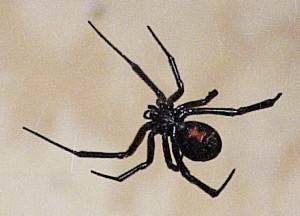
Sort enke
and brown recluse (loxosceles), all of three of which are common in the U.S.A.
The American tarantulas are large, hairy, black and orange spiders that occur throughout Central and South America. Locally they are known as the "araña de caballo" (horse spider). They feed on insects and small animals. The bite from one of these is painful but there is no record of it being fatal to humans. Their venom is the same as a bee sting. Tarantulas are sometimes called "banana spiders" as they like to make their homes in banana bunches. Cattle ranchers have problems with the tarantula because it can cause severe problems for cattle and horses if it bites the animal in the hoof and causes infection. The tarantula used to be much more common around the Rio Dulce, but the banana growers' and cattle ranchers' efforts to eradicate them have greatly reduced their numbers. The prevalent tarantula around the Rio Dulce belongs to the family Theraphosidae of the order Araneae.
The black widow and brown recluse are a different matter. Both are found in dark, hidden places and their venom can cause considerable pain and tissue damage. The most common place to get bitten is on the buttocks because these spiders are often found in outhouses and latrines, so watch where you sit! If you get bitten by a brown recluse you should seek medical attention to minimize the surrounding tissue damage. Left untreated, a serious bite from the brown recluse can cause extensive tissue damage (necrosis). Loxoceles reclusa, the brown recluse spider or violin spider is a poisonous nocturnal spider found throughout most of Guatemala. Adults are about 3/8 inch (10 mm) long and are light brown with a dark, violin-shaped mark on the back near the head. Most spiders have four pairs of eyes: two front, two rear and two to each side. Loxosceles is the only spider that cannot see to the rear as it is missing the rear pair of eyes. In humans their venom kills the tissue surrounding a bite and leaves a deep sore which can spread. Brown recluse bites should be treated by a doctor to avoid infection and further spreading of the tissue damage. Only rarely does a loxosceles bite result in death. Infants and the very old are most at risk.
The likelihood of a spider bite from a venomous spider is extremely low -- approaching zero if you are cautious. The vast majority of the arachnids around the Rio Dulce are harmless and the beautifully constructed webs of spiders are a common sight.
The other annoying members of the arachnid family are scorpions, locally referred to as "alacran". The Rio Dulce area is well supplied with these during the dry season. There are two common types which are the male and female of the same species. The male is a large black scorpion with the worst sting. The female is smaller, also black, but has pretty yellow legs and whose sting is a little less severe.
Do not walk in bare feet and never place your hand in a dark place or into a bag or sack without first looking inside. Always shake out articles of clothing, especially shoes, before putting them on. Scorpions are shy and tend to hide under bags and boxes placed on the floor. The pain from a scorpion sting is instantaneous and extreme for the first ten minutes. Some victims report dizziness and numbness of the mouth which appears after about ten minutes and persists for about 3 hours. These symptoms can be very alarming if you are not expecting them. Don't worry, the best treatment is to lie down and rest. After three hours the symptoms subside and the site of the sting will ache for several days. Other victims reports none of these symptoms and only report the equivalent of a bee sting.
Around the Rio Dulce one finds subtropical rain forest and mangrove rain forest. Most all plants here have very shallow root systems because the topsoil is so shallow. The trees often have buttressed root systems. Many of the trees are of the type that continuously shed their bark in order to throw off parasitic plants. Most of the plants are flowering (angiosperms) and most of them are woody. Vines are also common. Some vines grow up from the ground while others such as strangler figs (matapalos) take root at the tops of trees and grow downwards. The subtropical rain forest exhibits very wide bio-diversity. Right at the water's edge and on many of the cays in El Golfete one finds mangrove rain forest habitat with its much narrower bio-diversity. During the dry season, the waters of the Rio Dulce become brackish, hence, the mangroves.
For those who are unfamiliar with the tropics, taking a walk anywhere around the Rio Dulce will be a fantastic experience. The profusion of unfamiliar plants and insects will bring back memories of childhood when everything was new and unfamiliar. For those who are more interested in this experience, Hacienda Tijax and the Hotel Catamaran have guided and unguided nature walks where it is possible to learn much more about the rich contents of the rain forest.
The forest around the Rio Dulce contains tens of thousands of plant species ranging from algaes, fungi, mosses, lichens and liverworts to grasses, vines, palms, fruit trees, hardwood trees and everything in between. Just on the Hacienda Tijax farm near Fronteras, over 90 species of trees have been identified.
The topic of plants around the Rio Dulce is too broad to include in this overview so it has its own section. For more about the plants around the Rio Dulce.
Kilde: http://www.mayaparadise.com